A few weeks ago I described coming to my senses regarding Hampton, the remarkably original 49,000-mile survivor 2002 that I bought in 2019. For most of the car’s sojourn with me, I’ve hoarded its low mileage like virginity or Bitcoin, but I realized that it’s not like the car has 300 miles on it where any driving will take the sheen off an insanely low number; besides, I think that both the car and I would enjoy our relationship a lot more if we actually had some fun together instead of my doing the automotive equivalent of the plastic slipcovers my great-aunt in Queens had on all of her furniture.
So, although the weather didn’t cooperate with my plan to take Hampton on the final Nor’East 02 drive of the season (it was cancelled due to drenching rain), the car and I did have some proper time together while I had it here at the house for a month. My wife, Maire Anne, and I took it on a few nice drives, including one commemorating our 43rd “date-a-versary.” In the original event during our time at UMass Amherst, I picked up Maire Anne in my 1970 Triumph GT6+ and took her out to dinner—but then, by utter coincidence, I sold the car the next day. Fortunately, there was not the same symmetry with Hampton; both the car and the girl were still around in the morning.

A fine 43rd “date-a-versary” drive in Hampton.
I’ve long said that part of enjoying a vintage car is using it for mundane errand-running and having conversations that are triggered by the car’s presence. All 2002s, of course, excel at enabling this, since enough of them were sold in this country that, while they’re not as ubiquitous as Volkswagen Beetles and buses, they’re certainly part of the national collective baby-boomer automotive subconscious.
I can’t tell you how many people come up to me after I’ve parked a 2002, or when I’m returning to it, to say something like, “My roommate in college had one of those. I loved that car!” And Hampton, not a zingy color but looking just right in simple survivor white, is the perfect ambassador for this kind of interaction.
So for the month it was at the house, it was Need milk? It’s not raining? Take Hampton. I even used the car to pick up the Thanksgiving turkey. In all, I put more miles on Hampton in a month than I had in the previous two years I’d owned it.
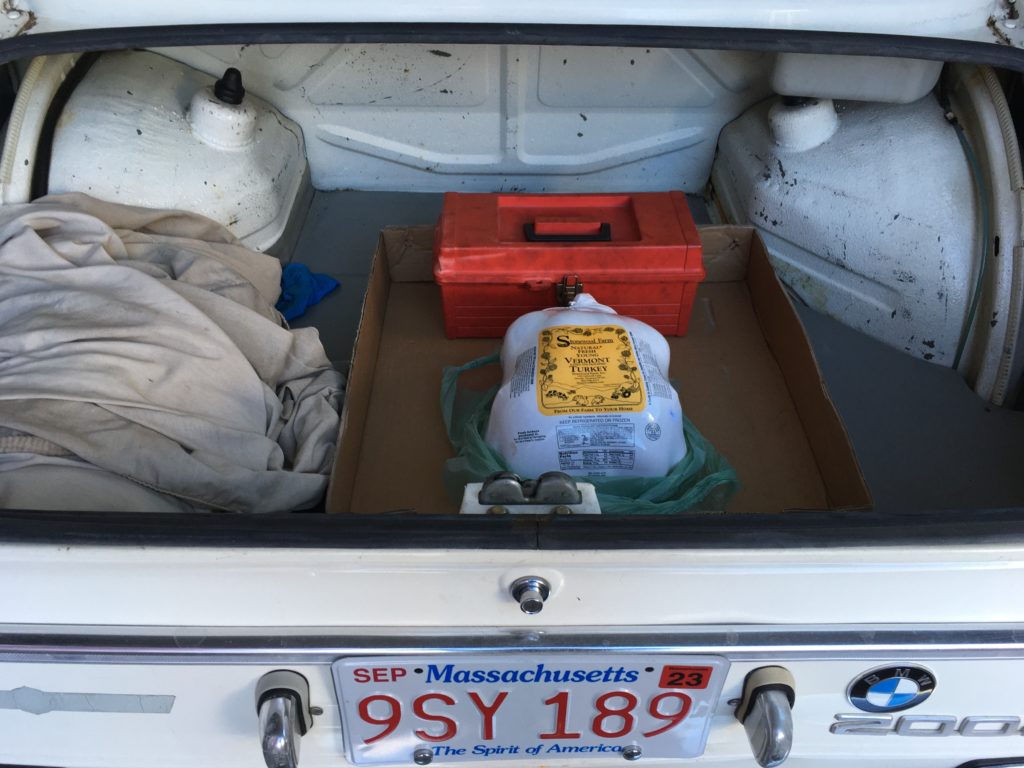
Yes, I packed tools. I mean, I’m not an idiot.
So what had started with my keeping Hampton at arm’s length, which slowly morphed to my warily embracing the car but not really enjoying it because it was bone-stock and thus so much softer and slower than either Louie the 2002tii or Bertha the former track rat, eventually turned into respect and appreciation. I realized how lucky I am to own a 2002 in this condition, and that I still own it only because I had the good fortune of its not meeting its reserve last spring on Bring a Trailer.
And then, after I replaced the car’s original shocks and struts with a good used set of Bilstein HDs, I began actually liking the car. That’s quite a turnaround.
As I described last week, I began thinking about what the winter held for projects. Hampton is slower than he should be, likely due to a combination of less-than-optimal carburetor jetting and the fact that the exhaust-gas recirculation plumbing is still present. While I would enjoy the car even more if it reacted appropriately when I mash the throttle, I’ve been hesitant to remove the EGR because it’s part of the car’s low-mileage pedigree. And wven if I do decide to have at the EGR, that’s hardly a project; it’s just removing a couple of fittings and replacing them with threaded plugs, easily accomplished in a short evening.
In contrast, tweaking the jetting is an iterative replace-and-drive thing, and once snow and salt are on the roads, that sort of testing would be off the table. So there wasn’t really enough meat on Hampton’s project bones to justify keeping the car in the garage at my house over the rapidly-approaching winter.
On the other hand, Louie, my Ran When Parked 1972 2002tii, is the embodiment of a good-sized project: He has a cracked head, although not cracked through a combustion chamber, which is what you usually mean when you say “cracked head.”
If you recall, when I bought the car sight-unseen in Louisville in the late winter of 2017, went down there with tools and parts, got it running, and drove it back, the trip was nearly derailed by a difficult-to-squelch oil drip from the back of the head onto the exhaust downpipe. At the time, I sealed the valve cover gasket with Permatex—”The Right Stuff”—but the root cause turned out to be that the back corner of the head was cracked through the boss holding one of the valve cover studs above the #4 spark-plug hole, and tightening down on that valve cover nut just caused the crack to yawn open.
Finding not only the crack but someone’s ham-fisted attempt to seal it with blue RTV explained a lot about why the car had been parked and was sitting for a decade.
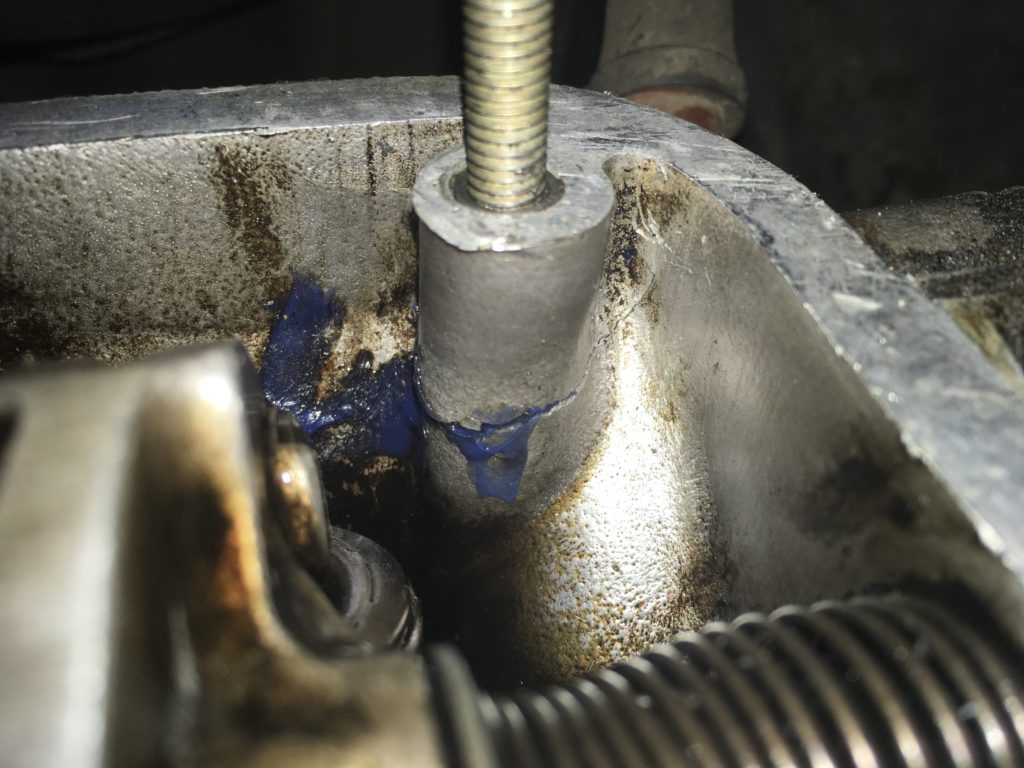
This was an eye-opening discovery.
After the purchase and the drive home, two additional head-related things occurred with Louie. First, while adjusting the valves prior to my driving the car down to the BMW CCA Foundation in the late winter of 2018 to be part of the “2002 Icon” exhibit, I discovered that a rocker-shaft end plug had worked its way out of the end of the intake-side rocker shaft and was dangling over the precipice of the timing case, ready to drop down inside and potentially wreak noisy expensive havoc.
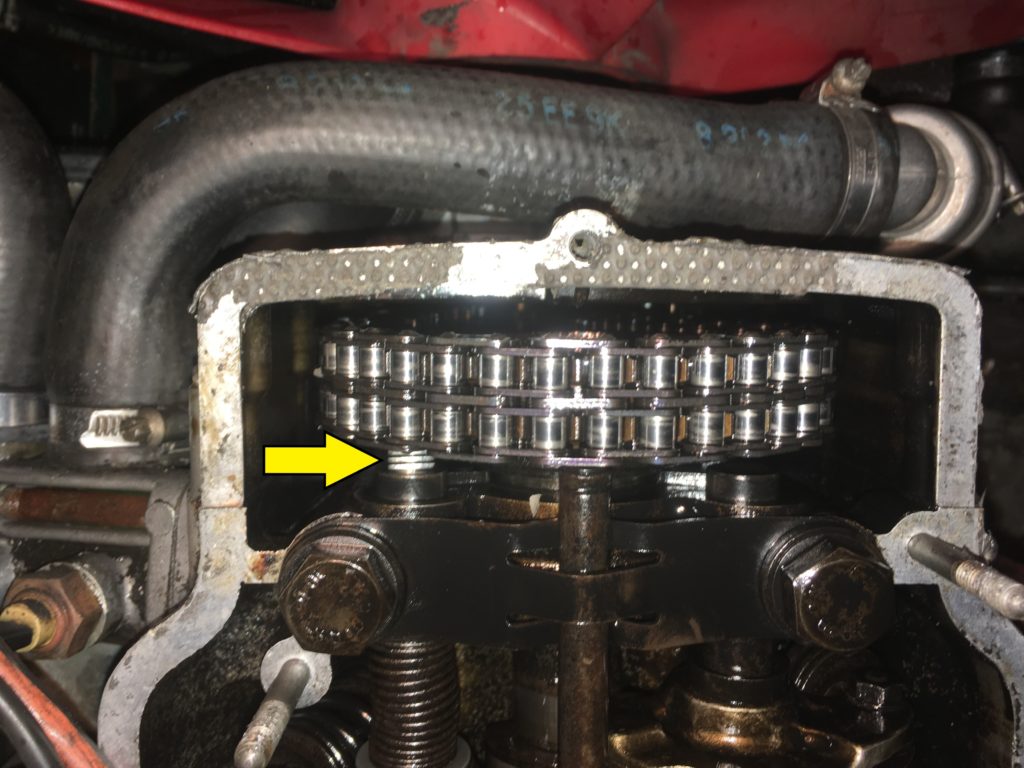
Yeesh!
At the time, since I was under the gun, I pushed the plug back in, and retained it with a wonderful little angled bracket that’s held in place by the head bolt and designed to keep the plug from committing suicide and taking the engine and my bank account with it.
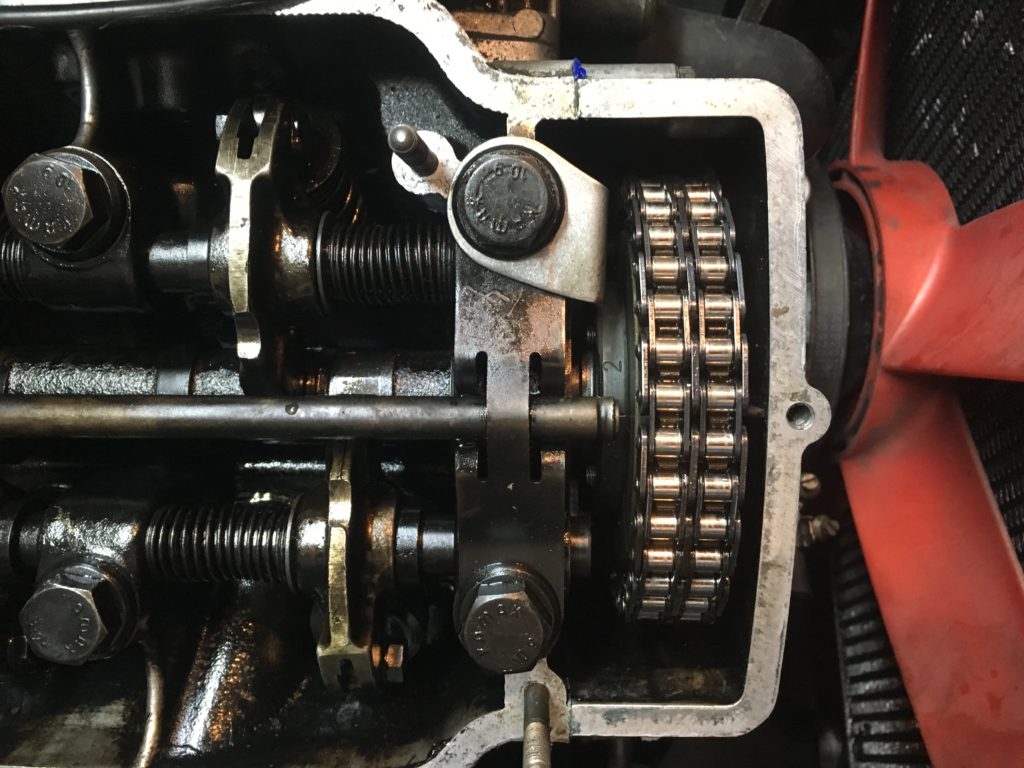
The right part for the right job.
The second problem presented itself after the Icon exhibit, when weather prevented me from driving Louie home. The car wound up in storage for months at Lance White’s shop in Cincinnati, Ohio (thanks, Lance!). When I finally got down there after Oktoberfest 2019 to pick it up, I found that my old nemesis, the oil leak onto the exhaust, was back—and in force: I discovered that the crack in the head had reached the outside, allowing oil to drip directly onto the exhaust manifold.
With guidance from Lance’s lead mechanic, the late great Safet Hatic, I burned the blue RTV and any stray oil out with a torch, sealed the crack with J-B Kwik Weld, waited a few hours, then carefully began driving. The repair not only held for the trip home, it continued to hold for months, then years. At some point I kind of shrugged and just kept using the car as if the J-B Weld was a permanent solution. Maybe it is; maybe it’s not. I suspect that it’s not. I need someone else to evaluate this.
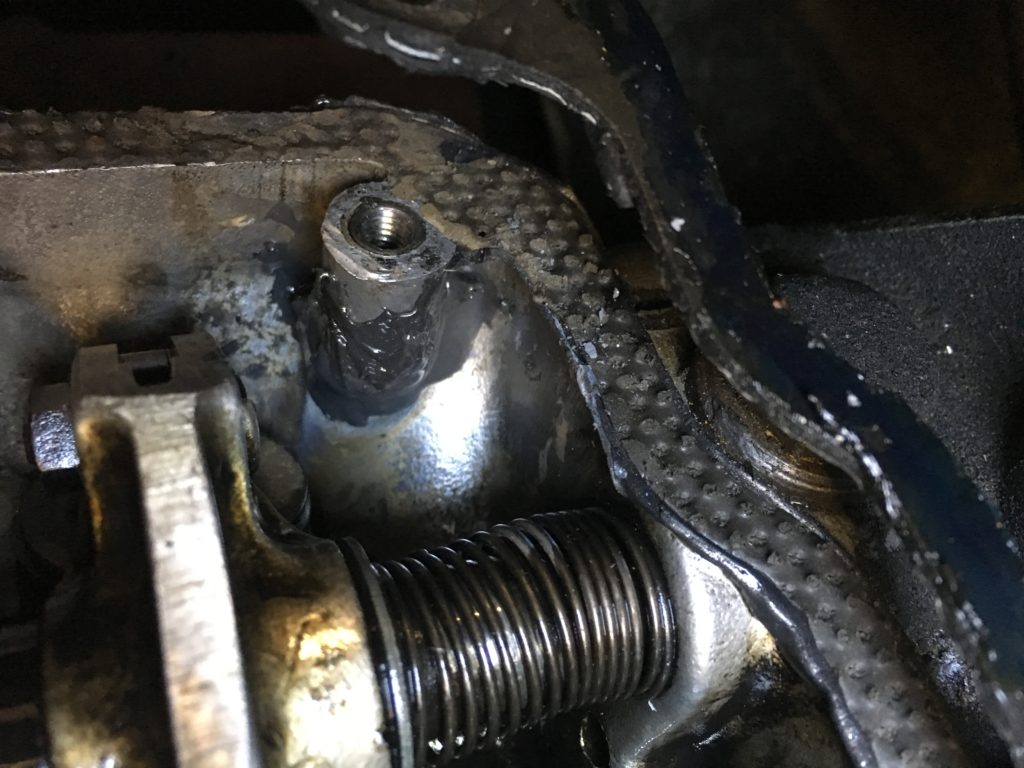
J-B Weld to the rescue!
But obviously, the combination of the crack, the never-intended-to-be-permanent J-B Weld repair, the loose rocker-shaft end plug and its angle-bracket repair, and the varnished condition of the head, indicating that it’s likely never been off the car (which almost certainly means that the head gasket is as rigid as soft cardboard and the valve seals are as brittle as an old man’s hips), together conspire to make the correct solution to pull the head and repair it, if that’s possible, and replace it if it isn’t. That’s going to be a winter project.
Thus a few days after Thanksgiving, I made the decision to swap Louie for Hampton. The timing, however, was less than optimal: Ss snow had been forecast, a few flurries had actually fallen, and the Massachusetts DPW responded by laying down the first application of road salt on the highways.
I was already aware of this due to a drive in my E39. It was clear, however, that this wasn’t rock salt, the stuff that raises a white cloud when you drive through it and that you hear smacking up and boring into your floors and wheel wells. Instead, it was one of the liquid-applied road treatments (since dried), either magnesium chloride (yuck) or salt brine (less yuck).
After returning from the drive in the E39, the tires didn’t look like Casper the Friendly Ghost, and I didn’t see any salt kicked up on the car, so the next day I drove out to my Fitchburg storage spaces in Hampton and retrieved Louie. Although the roads were salted, I didn’t feel like I was committing an act of violence against two vintage cars. I suppose that now that I have the largely-no-longer-mouse-infested truck, I could’ve rented a U-Haul auto transporter and floated both cars above the salty fray, but picking up and dropping off the transporter would have turned a two-hour quick exchange into the better part of a day.

You can barely make out the whitish sheen on Route 2. This was less than optimal, but sometimes we have to make tough choices.
Now, Louie, you may recall, has had a big slug of recent work. Last year I replaced his original bog-soft suspension with Bilstein HDs, H&R Sport lowering springs, and Suspension Techniques sway bars. This summer I retrofitted a modified Clardy a/c system. However, to my surprise, when I drove Louie, instead of feeling, “Ah, to be out of Hampton’s slowness and into a quick tii with a nice tight suspension,” my reaction was “Man, this thing just does not feel right.”
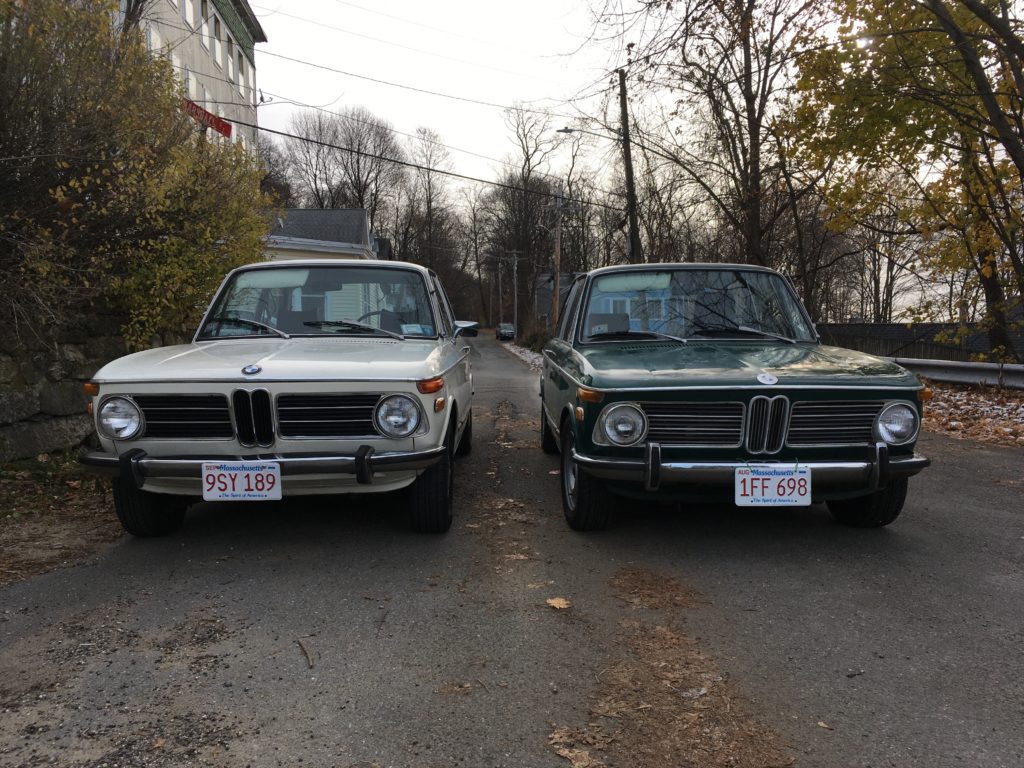
You can see how Louie (right) sits a bit more hunkered down than Hampton.
One of the subtle things that we come to appreciate about cars we’ve owned for years is the spate of sensations they engender, from the exhaust note to the way that the drivetrain couples through the body of the car and into your hands. When you modify a car, it often winds up changing a resonance, and the car never feels or sounds quite right after that. As I drove Louie the 50 miles home, I realized that I wasn’t reacting negatively to its lowered stiffer suspension. Instead, it was a combination of two things. The first was that the front sway bar was making noise, both because it was rubbing against the inside lip of the nose and because there was audible friction of the sway bar in its bushing.
The second thing was that there was an unusual and unpleasant engine resonance, almost certainly due to the presence of either the recently-installed a/c compressor, its bracket, or the a/c hoses.
Juxtaposed against this coarseness, Hampton no longer seemed like an overly-conservative near-stock slowpoke. No, instead, it was nearly heavenly in its “This is what a 2002 is supposed to sound and feel like,” and the fact that Louie was faster, stiffer, and lower didn’t matter. It just felt wrong. And it was my fault. So, add that to the winter project list.
Louie is now safely ensconced in the left rear garage space. I think of this as the project space, since it’s not in any other car’s way (this is the space where the Lotus sat for eight years). Since the vibration/resonance issue requires running and driving the car, I think I’ll dive into pulling the head first. Besides, the whole fix-the-crack-versus-replace-the-head issue may take a while to resolve.
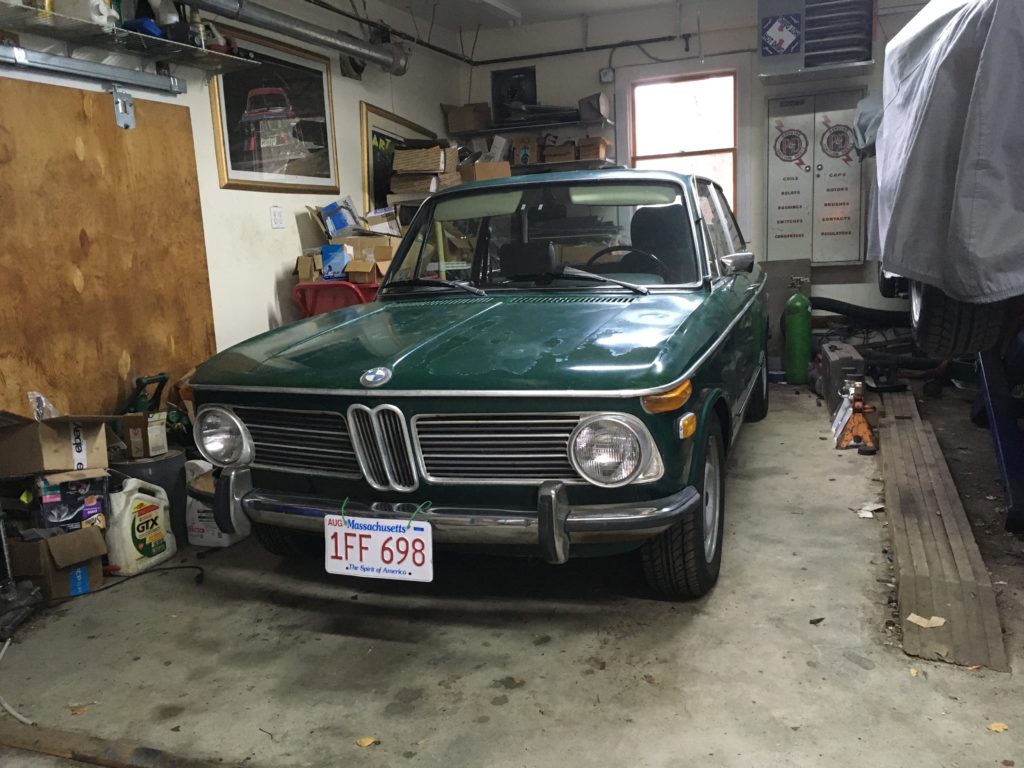
Home again.
I’m glad that I had a month of quality time with Hampton that righted the karma in our relationship. And I look forward to ripping Louie’s head off.—Rob Siegel
Rob’s new book, The Best of The Hack Mechanic, is available here on Amazon, as are his seven other books. Signed copies can be ordered directly from Rob here. Plus, five of Rob’s books are on sale for the holidays (cheaper from him than through Amazon).





















